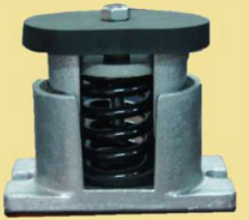Anechoic chambers are typically constructed on fully floating vibration-damping foundations, which achieve vibration isolation with low natural frequency and high damping through two mainstream technical approaches, ensuring the stability of the acoustic measurement environment: Vibration Damper Array Foundation It uses multiple sets of vibration dampers (such as spring-damper units, see the left schematic diagram) to support the foundation platform. Its core advantages are low natural frequency (usually ≤5Hz) and high damping coefficient, which can effectively isolate external vibrations (such as ground pulsation and equipment operation vibration) from transmitting to the anechoic chamber. However, it has the disadvantages of easy structural deformation and relatively high cost, and is suitable for professional acoustic laboratories with extremely high requirements for vibration isolation accuracy. Multi-layer Composite Foundation Structure It is constructed in layers from concrete, asphalt, dry river sand, waterproof materials, damping materials, etc. (the right structural schematic diagram shows a composite design of "support layer - micro-vibration isolation layer - sound wave reflection layer - high damping layer - waterproof layer"). It has both good vibration damping effect and low natural frequency, and features strong structural stability and relatively controllable cost. It is widely used in industrial anechoic chambers, large-scale acoustic test cabins and other scenarios. Both foundation forms block the interference of external vibrations on the internal precision acoustic measurements (such as sound pressure level and sound insulation measurement) of the anechoic chamber through the technical logic of "reducing natural frequency + enhancing damping", providing a stable vibration environment base for the acoustic system.

//
Vibration Damping System
Anechoic chambers are typically constructed on fully floating vibration-damping foundations, whi
Request a Quote





